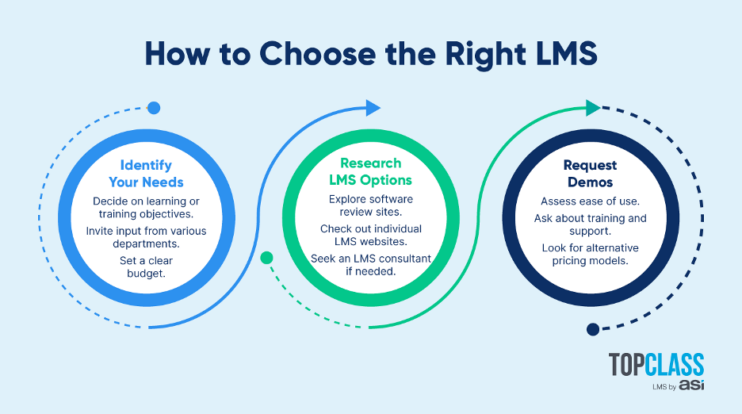Why Should Nonprofits Invest in Professional Development?

Nonprofits face a critical question: How do we build stronger, more sustainable organizations that can make a lasting impact? The answer lies in one often-overlooked strategy: professional development.
Professional development isn’t just a one-time initiative—it’s a powerful catalyst for growth that creates a ripple effect throughout every level of your nonprofit. Whether you’re empowering members with new skills, developing staff expertise, or providing beneficiaries with tools for success, professional development ensures that every aspect of your organization achieves its full potential.
Whether you want to offer learning opportunities to one audience or all three, we’ll explore the impact of doing so.
How Professional Development Opportunities Grow Member Communities
If you run a membership organization, providing professional development opportunities can create a powerful revenue stream. Learning opportunities create an ecosystem where individuals can grow, connect, and contribute meaningfully to their communities.
These opportunities can cover industry-specific skills, leadership training, communication, or even personal development. For example, a nonprofit focused on education might offer its members access to professional development workshops, teaching certifications, and classroom management training.
One of the most effective ways to deliver these opportunities is through a learning management system (LMS) for nonprofits. An LMS allows organizations to provide a centralized, scalable platform where members can access various learning materials, courses, and resources at their own pace. Whether for online courses, webinars, certification programs, or specialized workshops, an LMS helps streamline the development process and ensures all members have equal access to your program.
Benefits of Learning Opportunities for Members
Here’s why membership-based nonprofits commonly offer professional development:
- Enhance membership value. Professional development opportunities offer tangible benefits beyond networking or industry events. By providing specialized training, certifications, and skill-building workshops, membership organizations can increase the perceived value of membership.
- Attract and retain members. A well-designed professional development program acts as a magnet for new members who are seeking growth opportunities. These programs also boost retention by offering ongoing learning that keeps current members engaged, ensuring they continue to find value in being part of your organization.
- Strengthen member skills. By providing targeted skill-building opportunities, nonprofits help their members enhance their careers while improving the broader sector. Members gain valuable skills that make them more effective professionals, while also contributing to your organization’s overall impact and success.
Ultimately, investing in professional development helps build a community of skilled, motivated, and committed members. They’ll feel more connected to your organization and better prepared to support your mission for the long term.
How Professional Development Improves Your Workforce
Provide professional development opportunities to keep your staff engaged, skilled, and motivated to do their best work. These might include leadership training, technical skill workshops, certifications, or mentorship programs.
By offering various learning experiences, your nonprofit can equip its staff with the tools and knowledge to succeed, adapt, and grow in their roles. Investing in workforce development not only enhances individual performance but also strengthens your organization’s overall impact.
You might use an LMS to provide or design your own courses. You can also send staff to conferences hosted by other organizations to expose them to new ideas and network with peers in the sector. Alternatively, hosting in-house workshops or lunch-and-learns, facilitated by guest speakers or internal leaders, is another great option.
Benefits of Learning Opportunities for Staff
Here are some key reasons to encourage ongoing learning within your nonprofit’s workplace:
- Build a more skilled and effective team. Training staff helps build capacity within your organization. Whether it’s enhancing fundraising skills, disaster response communications, leadership abilities, or industry knowledge, learning opportunities allow them to become more effective in their roles.
- Increase staff retention. Investing in staff development signals that your nonprofit values its employees, leading to higher job satisfaction and reduced turnover. In the nonprofit sector, budgets can be tight, so retaining experienced staff is critical to maintaining continuity and organizational knowledge.
- Strengthen leadership pipelines. By offering leadership training, you can create a pipeline of future leaders. This ensures continuity of vision and helps you build teams that can sustainably drive your mission forward.
Investing in professional development for staff creates a more capable workforce that is better equipped and more committed to fulfilling your organization’s mission. These efforts contribute to long-term sustainability, ensuring your nonprofit remains agile and resilient in the years to come.
How Offering Professional Development Supports Beneficiaries
While offering professional development to staff and members is more common, providing it to beneficiaries can also be incredibly impactful. For example, a nonprofit that offers job training to help individuals improve their skills and employability can make a tangible difference in their lives.
Investing in professional development for beneficiaries is especially valuable when your nonprofit aims to drive long-term outcomes like career advancement or community empowerment. Whether your organization focuses on education, health, or social services, offering job training, workshops, or mentorship can strengthen your mission and create lasting change.
Benefits of Learning Opportunities for Beneficiaries
To determine whether investing in professional development is the right move for your mission, consider these advantages:
- Create long-term change. Nonprofits that offer professional development to beneficiaries—whether through job training, entrepreneurship education, or leadership development—help individuals gain skills that lead to self-sufficiency and economic mobility. This, in turn, strengthens the community as a whole.
- Grow service impact. When beneficiaries gain new skills, they become more capable of engaging with your services, spreading your nonprofit’s message, or teaching others. This expands your nonprofit’s impact beyond the immediate beneficiary.
- Attract more funding. Foundations and donors increasingly value nonprofits that provide helpful services to beneficiaries. Especially if you can demonstrate the tangible impact of professional development on beneficiaries, these initiatives can be great for attracting grants and donations.
Not to mention, as beneficiaries gain skills and/or become employed, they can contribute to your mission or even become supporters themselves, further strengthening your nonprofit’s sustainability.
Practical Steps for Nonprofits Considering Professional Development Programs
Investing in professional development is a powerful way to advance your nonprofit’s mission. The key to success is selecting the right tools and structuring your programs in a sustainable way.
For whichever group you’re targeting—staff, members, or beneficiaries—conduct a needs assessment to understand where professional development will be most helpful. What skills do your staff need to fulfill your organization’s mission? What kinds of growth opportunities are your members seeking? What job or life skills will most benefit your beneficiaries?
If you’ve determined that offering learning opportunities is the right move, your next step is to select tools to power your program. In many cases, this is an LMS. TopClass recommends taking the following steps to select your platform:

- Assess your needs. Determine your learning program goals and the types of opportunities you’ll offer. Gather input from different departments to set clear priorities. Then, create a budget that accounts for both upfront costs and ongoing expenses like data migration.
- Research LMS options. Explore providers’ websites and popular review sites like Capterra to find honest user reviews. You can always work with a consultant who knows about different providers to find the best solution. In your search, look for an LMS that offers features like custom learning pathways, webinar functionality, online testing tools, reporting, and collaborative learning (e.g., discussion forums).
- Request demos of your top choices. Pay attention to ease of use, available training, support, and different price models that fit your needs.
Your best approach is to choose an LMS that integrates with your CRM, enabling you to easily connect your learning and broader engagement efforts for a more cohesive experience.
By selecting the right LMS and offering targeted learning opportunities, you’ll enhance your community’s capabilities and strengthen your overall mission. Keep your programs flexible and sustainable, and continually assess their impact to ensure they meet your organization’s evolving needs.
Launch Your Nonprofit’s Learning Program
Offering effective professional development opportunities is an essential strategy for any nonprofit looking to strengthen its workforce, engage its members, or empower its beneficiaries.
The key to success hinges on sustainability. Rather than launching everything at once, consider rolling out new learning opportunities regularly. Regardless of your audience, a program that is scalable and aligned with their needs will deliver long-term value to both learners and your nonprofit.

